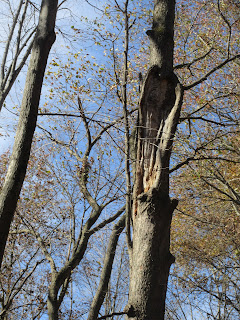"See Good Trees" is my motto when doing improvement work in timber. Look for the good ones and get rid of trees competing with them. For timber growers, a good tree has a straight stem, good natural pruning, a wide healthy crown, and no forks or tight branch angles with included bark. This red maple demonstrates the danger of forks and tight branch angles. Trees like this one tend to be damaged by wind and ice.
Do we need to get rid of this tree now? We can utilize it for firewood, but currently we are covered up in dead ash trees, and those need to be harvested before we go after a live tree. Is it interfering with a good crop tree? If not, just leave it for the time being. Rot is going to work its way down the stem, but there will still be a good log for ten or fifteen years. You can also leave a tree like this to serve as a wildlife tree. That break will work as a good nesting site, and possibly a den.
Here's a bad fork with included bark and rot progressing.
Another bad fork with hidden bark included, but sound on top.
This one is a sound fork with both wood and bark where they should be. A fork is the top end of merchantability for sawtimber. You need a minimum of 8' 6" for a hardwood log to be merchantable. If a tree forks below that it will never go to the sawmill.
This is a good branch angle with the limb going back all the way to the pith. The tighter the branching angle, the more likely bark will be trapped between the limb and the stem.
















No comments:
Post a Comment